Mawson Zoo: Improving Project Control with a PPP Framework
VerifiedAdded on 2023/06/04
|8
|2100
|319
Report
AI Summary
This report examines project management methodologies applicable to Mawson Zoo, which currently operates at a tactical level using PMBoK but faces challenges due to isolated project implementations. It advocates for an organization-wide Portfolio/Program/Project (PPP) framework and explores adaptive methodologies such as Agile, Lean, Kanban, Critical Path, and Extreme Project Management. The report details the phases and benefits of each methodology, emphasizing adaptability and scalability to address issues like project delays, budget overruns, and stakeholder disengagement. Lean project management is specifically recommended for its ability to identify and eliminate waste, promoting continuous improvement and enhanced customer value. The ultimate goal is to streamline managerial functions and improve overall project control at Mawson Zoo.
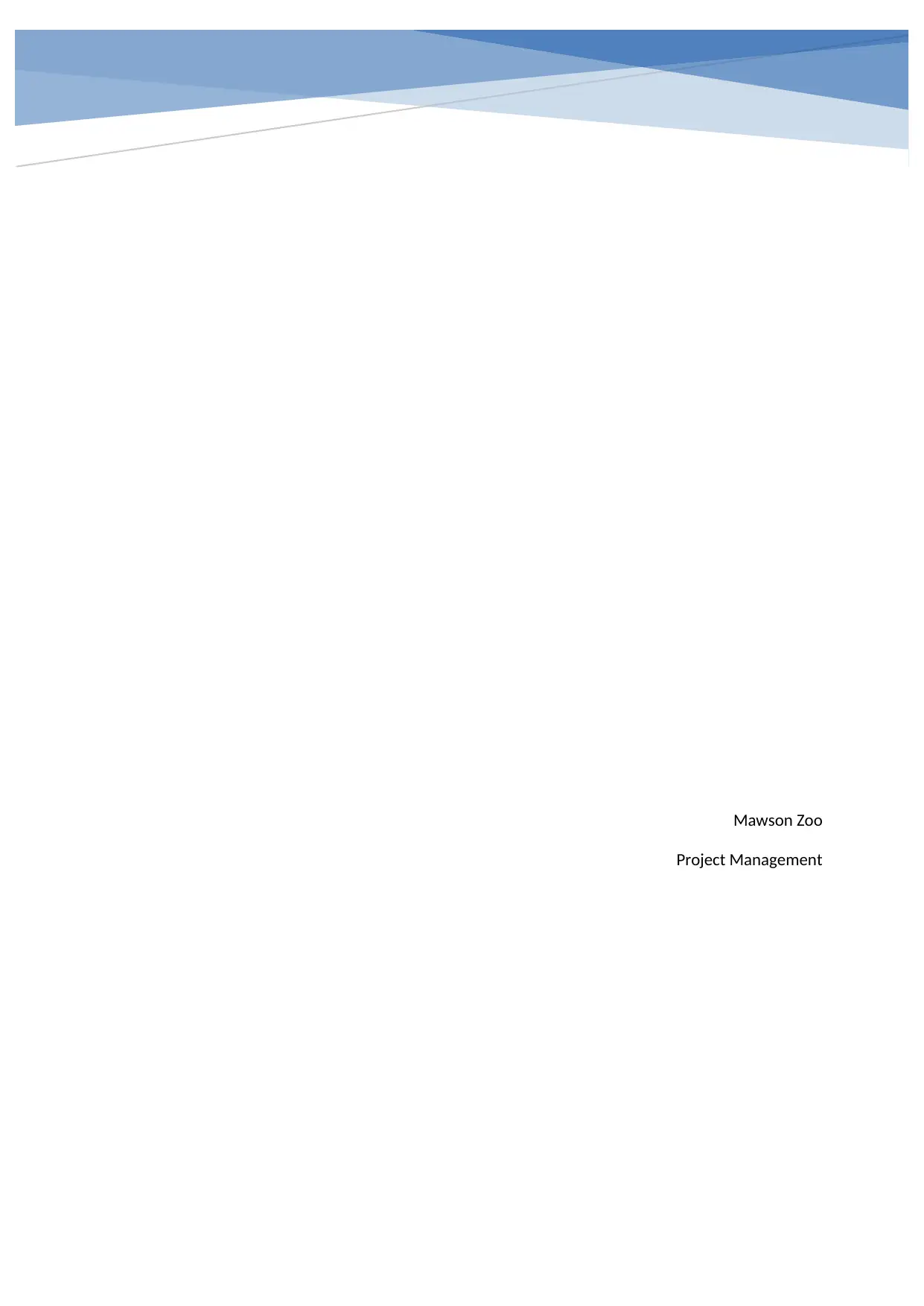
Mawson Zoo
Project Management
Project Management
Paraphrase This Document
Need a fresh take? Get an instant paraphrase of this document with our AI Paraphraser
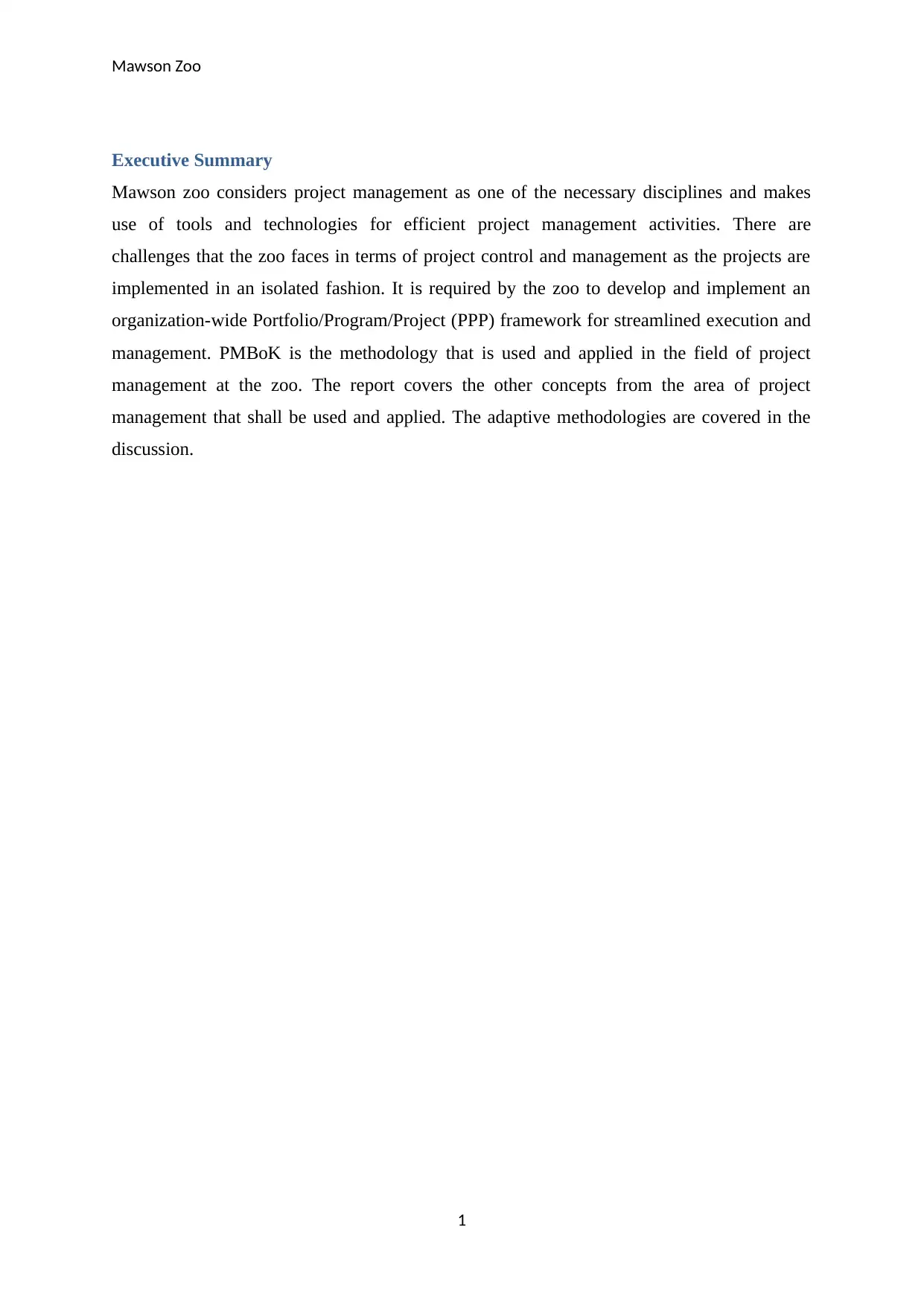
Mawson Zoo
Executive Summary
Mawson zoo considers project management as one of the necessary disciplines and makes
use of tools and technologies for efficient project management activities. There are
challenges that the zoo faces in terms of project control and management as the projects are
implemented in an isolated fashion. It is required by the zoo to develop and implement an
organization-wide Portfolio/Program/Project (PPP) framework for streamlined execution and
management. PMBoK is the methodology that is used and applied in the field of project
management at the zoo. The report covers the other concepts from the area of project
management that shall be used and applied. The adaptive methodologies are covered in the
discussion.
1
Executive Summary
Mawson zoo considers project management as one of the necessary disciplines and makes
use of tools and technologies for efficient project management activities. There are
challenges that the zoo faces in terms of project control and management as the projects are
implemented in an isolated fashion. It is required by the zoo to develop and implement an
organization-wide Portfolio/Program/Project (PPP) framework for streamlined execution and
management. PMBoK is the methodology that is used and applied in the field of project
management at the zoo. The report covers the other concepts from the area of project
management that shall be used and applied. The adaptive methodologies are covered in the
discussion.
1
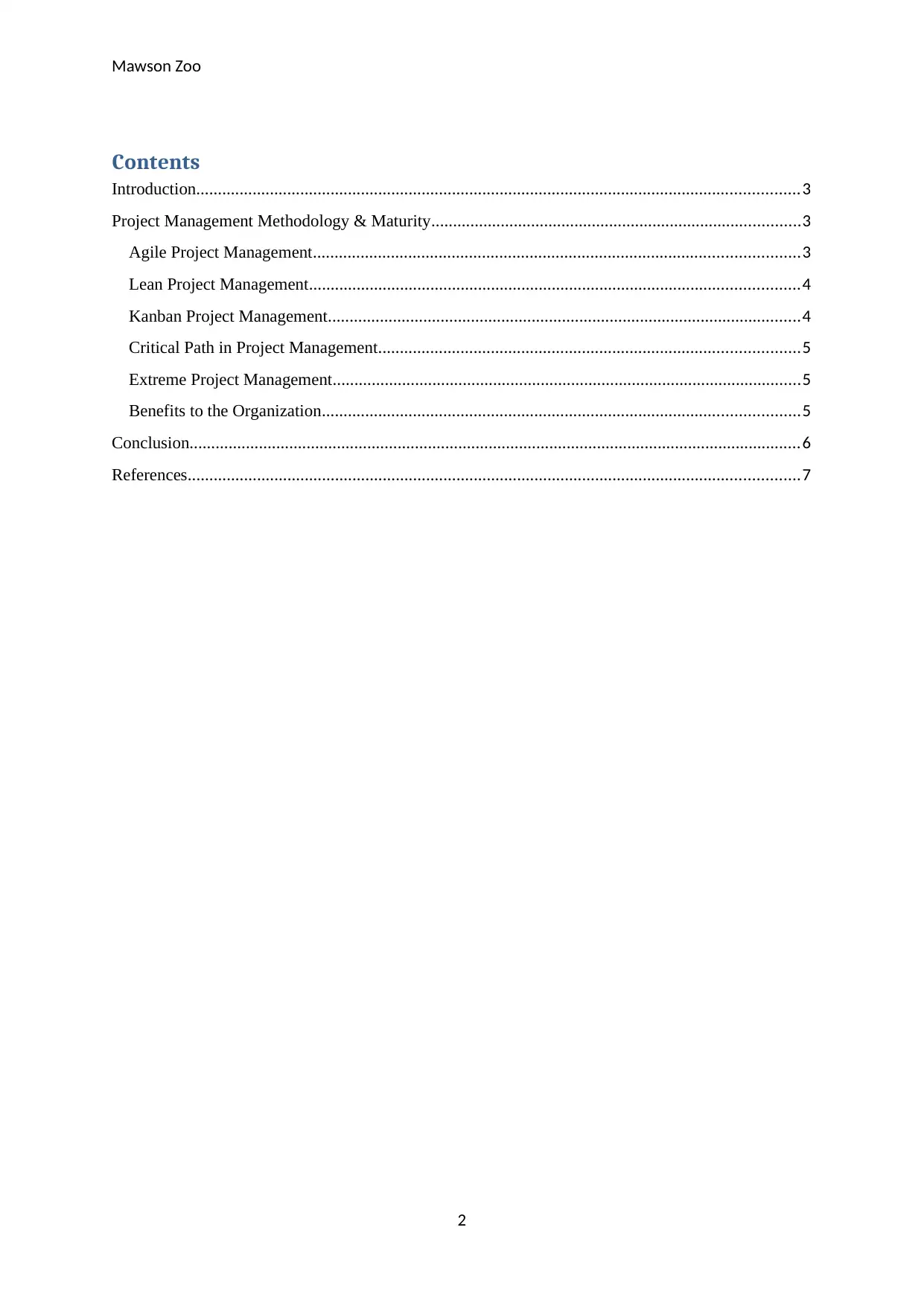
Mawson Zoo
Contents
Introduction...........................................................................................................................................3
Project Management Methodology & Maturity.....................................................................................3
Agile Project Management................................................................................................................3
Lean Project Management.................................................................................................................4
Kanban Project Management.............................................................................................................4
Critical Path in Project Management.................................................................................................5
Extreme Project Management............................................................................................................5
Benefits to the Organization..............................................................................................................5
Conclusion.............................................................................................................................................6
References.............................................................................................................................................7
2
Contents
Introduction...........................................................................................................................................3
Project Management Methodology & Maturity.....................................................................................3
Agile Project Management................................................................................................................3
Lean Project Management.................................................................................................................4
Kanban Project Management.............................................................................................................4
Critical Path in Project Management.................................................................................................5
Extreme Project Management............................................................................................................5
Benefits to the Organization..............................................................................................................5
Conclusion.............................................................................................................................................6
References.............................................................................................................................................7
2
⊘ This is a preview!⊘
Do you want full access?
Subscribe today to unlock all pages.

Trusted by 1+ million students worldwide
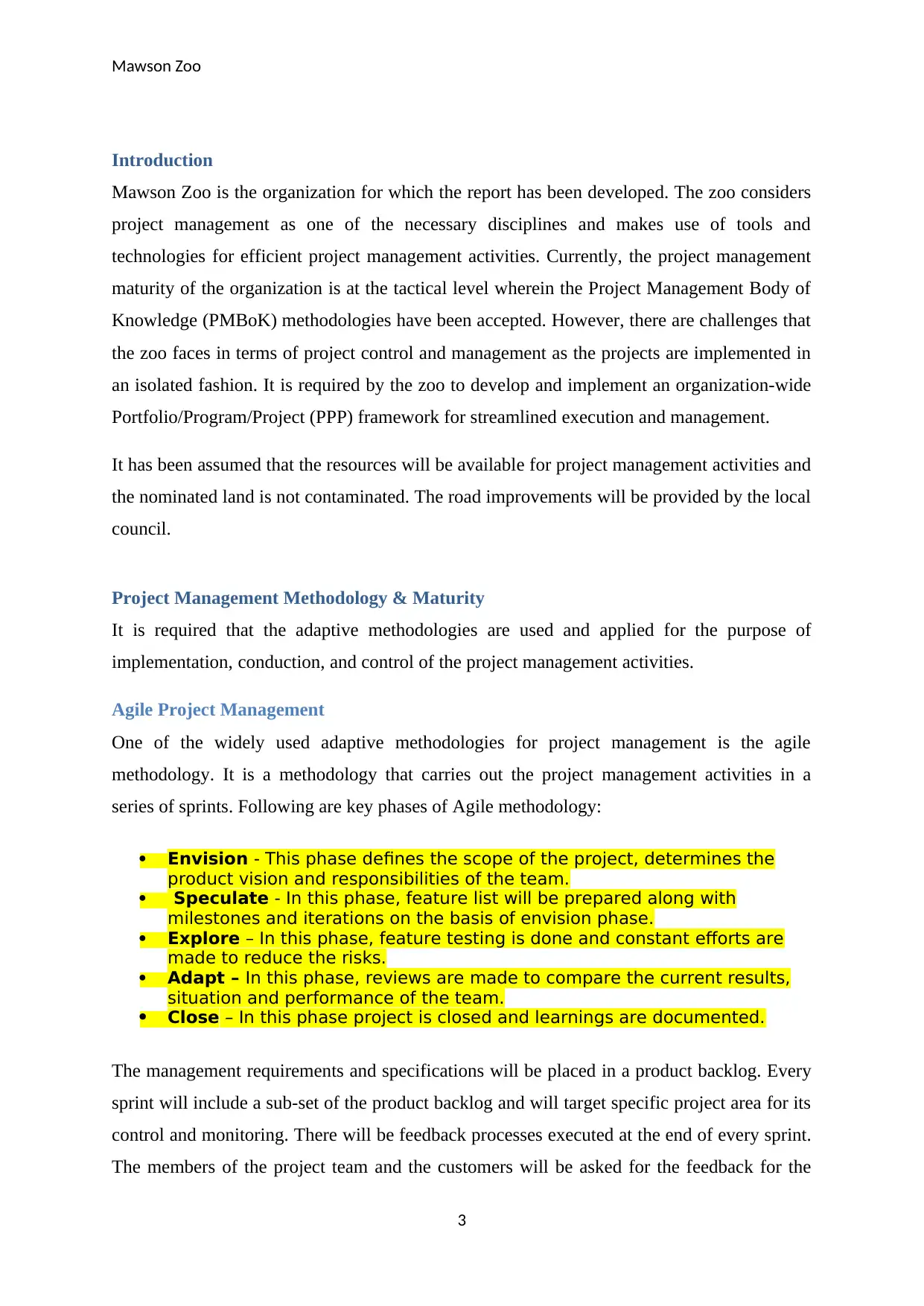
Mawson Zoo
Introduction
Mawson Zoo is the organization for which the report has been developed. The zoo considers
project management as one of the necessary disciplines and makes use of tools and
technologies for efficient project management activities. Currently, the project management
maturity of the organization is at the tactical level wherein the Project Management Body of
Knowledge (PMBoK) methodologies have been accepted. However, there are challenges that
the zoo faces in terms of project control and management as the projects are implemented in
an isolated fashion. It is required by the zoo to develop and implement an organization-wide
Portfolio/Program/Project (PPP) framework for streamlined execution and management.
It has been assumed that the resources will be available for project management activities and
the nominated land is not contaminated. The road improvements will be provided by the local
council.
Project Management Methodology & Maturity
It is required that the adaptive methodologies are used and applied for the purpose of
implementation, conduction, and control of the project management activities.
Agile Project Management
One of the widely used adaptive methodologies for project management is the agile
methodology. It is a methodology that carries out the project management activities in a
series of sprints. Following are key phases of Agile methodology:
Envision - This phase defines the scope of the project, determines the
product vision and responsibilities of the team.
Speculate - In this phase, feature list will be prepared along with
milestones and iterations on the basis of envision phase.
Explore – In this phase, feature testing is done and constant efforts are
made to reduce the risks.
Adapt – In this phase, reviews are made to compare the current results,
situation and performance of the team.
Close – In this phase project is closed and learnings are documented.
The management requirements and specifications will be placed in a product backlog. Every
sprint will include a sub-set of the product backlog and will target specific project area for its
control and monitoring. There will be feedback processes executed at the end of every sprint.
The members of the project team and the customers will be asked for the feedback for the
3
Introduction
Mawson Zoo is the organization for which the report has been developed. The zoo considers
project management as one of the necessary disciplines and makes use of tools and
technologies for efficient project management activities. Currently, the project management
maturity of the organization is at the tactical level wherein the Project Management Body of
Knowledge (PMBoK) methodologies have been accepted. However, there are challenges that
the zoo faces in terms of project control and management as the projects are implemented in
an isolated fashion. It is required by the zoo to develop and implement an organization-wide
Portfolio/Program/Project (PPP) framework for streamlined execution and management.
It has been assumed that the resources will be available for project management activities and
the nominated land is not contaminated. The road improvements will be provided by the local
council.
Project Management Methodology & Maturity
It is required that the adaptive methodologies are used and applied for the purpose of
implementation, conduction, and control of the project management activities.
Agile Project Management
One of the widely used adaptive methodologies for project management is the agile
methodology. It is a methodology that carries out the project management activities in a
series of sprints. Following are key phases of Agile methodology:
Envision - This phase defines the scope of the project, determines the
product vision and responsibilities of the team.
Speculate - In this phase, feature list will be prepared along with
milestones and iterations on the basis of envision phase.
Explore – In this phase, feature testing is done and constant efforts are
made to reduce the risks.
Adapt – In this phase, reviews are made to compare the current results,
situation and performance of the team.
Close – In this phase project is closed and learnings are documented.
The management requirements and specifications will be placed in a product backlog. Every
sprint will include a sub-set of the product backlog and will target specific project area for its
control and monitoring. There will be feedback processes executed at the end of every sprint.
The members of the project team and the customers will be asked for the feedback for the
3
Paraphrase This Document
Need a fresh take? Get an instant paraphrase of this document with our AI Paraphraser
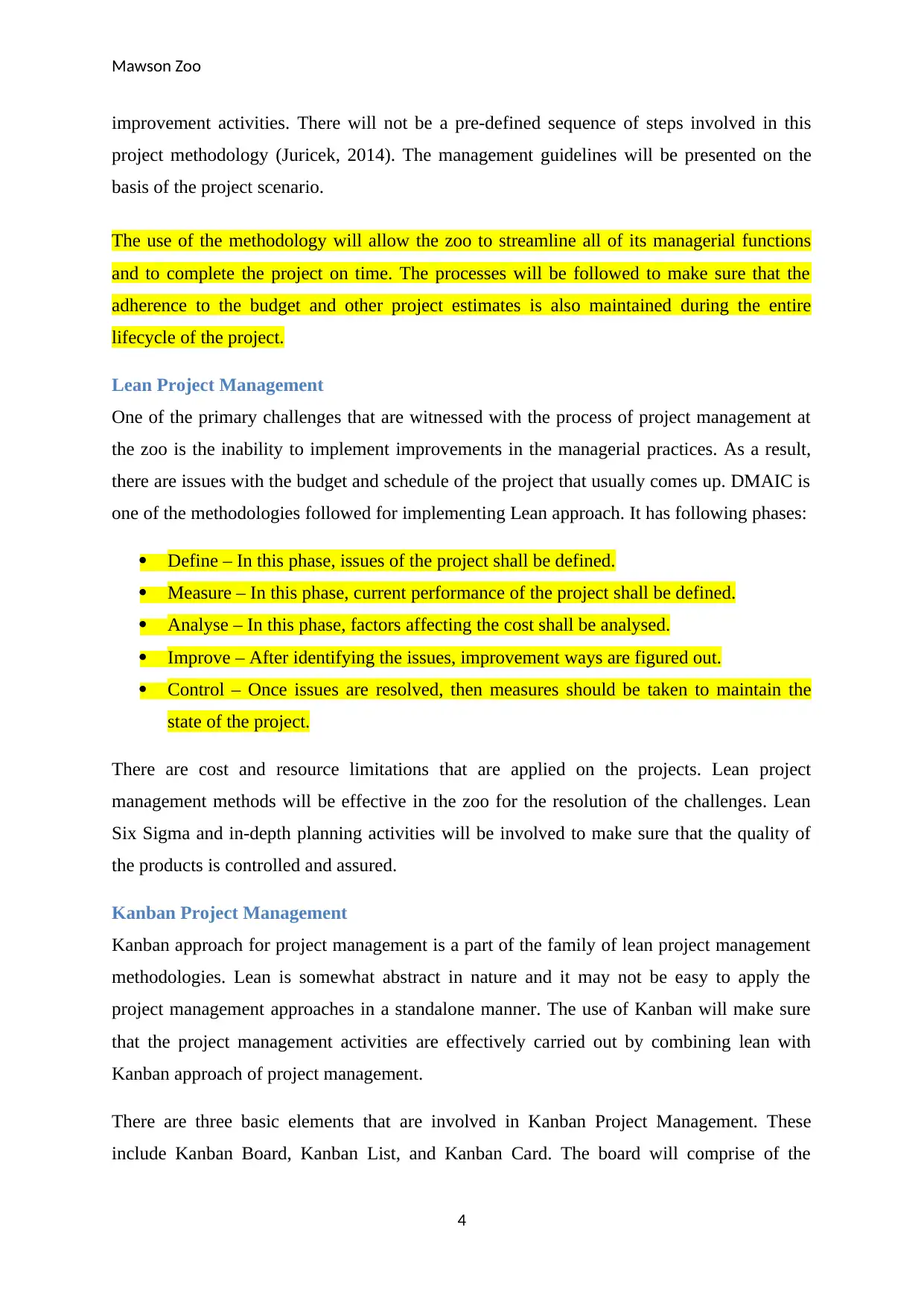
Mawson Zoo
improvement activities. There will not be a pre-defined sequence of steps involved in this
project methodology (Juricek, 2014). The management guidelines will be presented on the
basis of the project scenario.
The use of the methodology will allow the zoo to streamline all of its managerial functions
and to complete the project on time. The processes will be followed to make sure that the
adherence to the budget and other project estimates is also maintained during the entire
lifecycle of the project.
Lean Project Management
One of the primary challenges that are witnessed with the process of project management at
the zoo is the inability to implement improvements in the managerial practices. As a result,
there are issues with the budget and schedule of the project that usually comes up. DMAIC is
one of the methodologies followed for implementing Lean approach. It has following phases:
Define – In this phase, issues of the project shall be defined.
Measure – In this phase, current performance of the project shall be defined.
Analyse – In this phase, factors affecting the cost shall be analysed.
Improve – After identifying the issues, improvement ways are figured out.
Control – Once issues are resolved, then measures should be taken to maintain the
state of the project.
There are cost and resource limitations that are applied on the projects. Lean project
management methods will be effective in the zoo for the resolution of the challenges. Lean
Six Sigma and in-depth planning activities will be involved to make sure that the quality of
the products is controlled and assured.
Kanban Project Management
Kanban approach for project management is a part of the family of lean project management
methodologies. Lean is somewhat abstract in nature and it may not be easy to apply the
project management approaches in a standalone manner. The use of Kanban will make sure
that the project management activities are effectively carried out by combining lean with
Kanban approach of project management.
There are three basic elements that are involved in Kanban Project Management. These
include Kanban Board, Kanban List, and Kanban Card. The board will comprise of the
4
improvement activities. There will not be a pre-defined sequence of steps involved in this
project methodology (Juricek, 2014). The management guidelines will be presented on the
basis of the project scenario.
The use of the methodology will allow the zoo to streamline all of its managerial functions
and to complete the project on time. The processes will be followed to make sure that the
adherence to the budget and other project estimates is also maintained during the entire
lifecycle of the project.
Lean Project Management
One of the primary challenges that are witnessed with the process of project management at
the zoo is the inability to implement improvements in the managerial practices. As a result,
there are issues with the budget and schedule of the project that usually comes up. DMAIC is
one of the methodologies followed for implementing Lean approach. It has following phases:
Define – In this phase, issues of the project shall be defined.
Measure – In this phase, current performance of the project shall be defined.
Analyse – In this phase, factors affecting the cost shall be analysed.
Improve – After identifying the issues, improvement ways are figured out.
Control – Once issues are resolved, then measures should be taken to maintain the
state of the project.
There are cost and resource limitations that are applied on the projects. Lean project
management methods will be effective in the zoo for the resolution of the challenges. Lean
Six Sigma and in-depth planning activities will be involved to make sure that the quality of
the products is controlled and assured.
Kanban Project Management
Kanban approach for project management is a part of the family of lean project management
methodologies. Lean is somewhat abstract in nature and it may not be easy to apply the
project management approaches in a standalone manner. The use of Kanban will make sure
that the project management activities are effectively carried out by combining lean with
Kanban approach of project management.
There are three basic elements that are involved in Kanban Project Management. These
include Kanban Board, Kanban List, and Kanban Card. The board will comprise of the
4
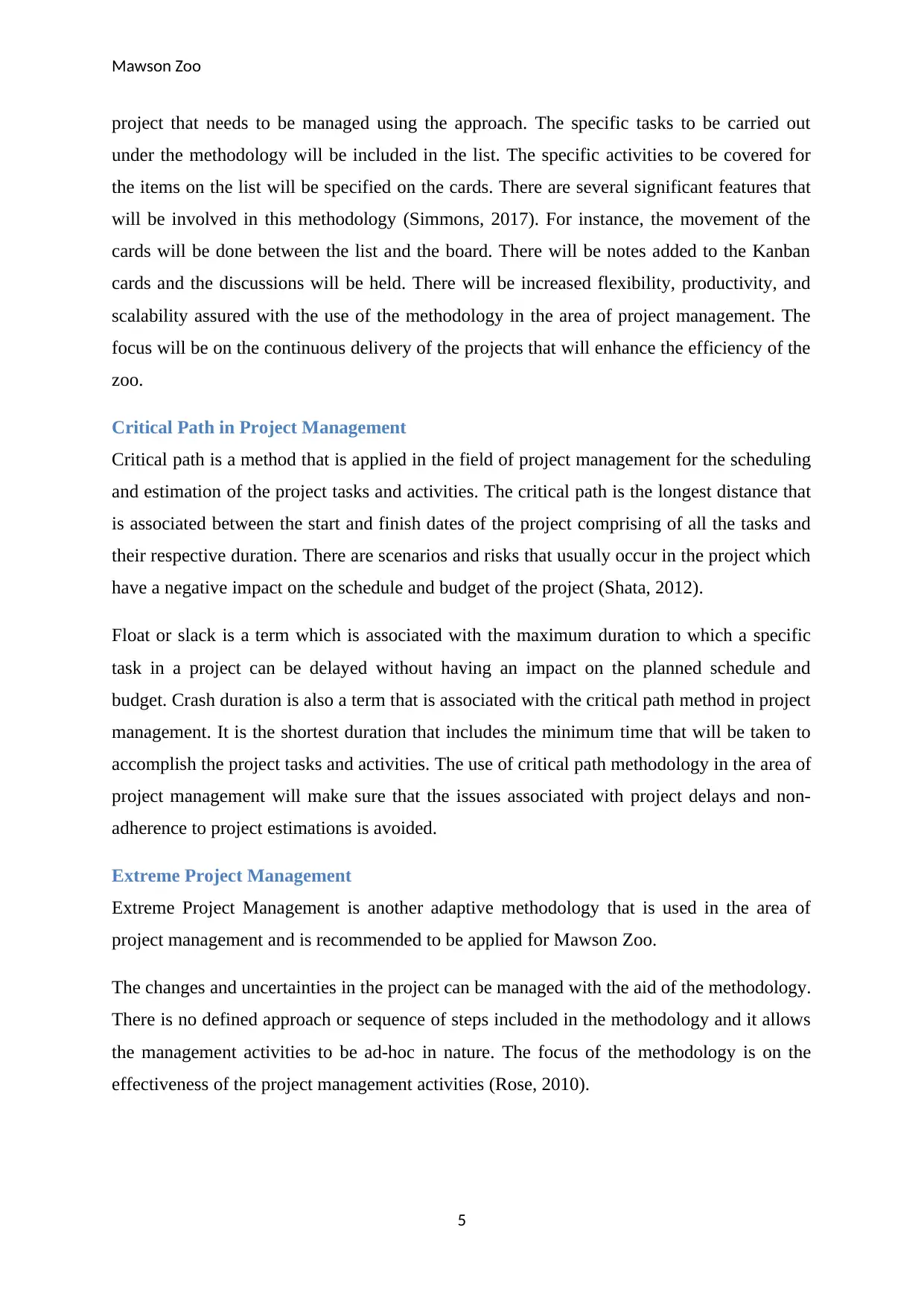
Mawson Zoo
project that needs to be managed using the approach. The specific tasks to be carried out
under the methodology will be included in the list. The specific activities to be covered for
the items on the list will be specified on the cards. There are several significant features that
will be involved in this methodology (Simmons, 2017). For instance, the movement of the
cards will be done between the list and the board. There will be notes added to the Kanban
cards and the discussions will be held. There will be increased flexibility, productivity, and
scalability assured with the use of the methodology in the area of project management. The
focus will be on the continuous delivery of the projects that will enhance the efficiency of the
zoo.
Critical Path in Project Management
Critical path is a method that is applied in the field of project management for the scheduling
and estimation of the project tasks and activities. The critical path is the longest distance that
is associated between the start and finish dates of the project comprising of all the tasks and
their respective duration. There are scenarios and risks that usually occur in the project which
have a negative impact on the schedule and budget of the project (Shata, 2012).
Float or slack is a term which is associated with the maximum duration to which a specific
task in a project can be delayed without having an impact on the planned schedule and
budget. Crash duration is also a term that is associated with the critical path method in project
management. It is the shortest duration that includes the minimum time that will be taken to
accomplish the project tasks and activities. The use of critical path methodology in the area of
project management will make sure that the issues associated with project delays and non-
adherence to project estimations is avoided.
Extreme Project Management
Extreme Project Management is another adaptive methodology that is used in the area of
project management and is recommended to be applied for Mawson Zoo.
The changes and uncertainties in the project can be managed with the aid of the methodology.
There is no defined approach or sequence of steps included in the methodology and it allows
the management activities to be ad-hoc in nature. The focus of the methodology is on the
effectiveness of the project management activities (Rose, 2010).
5
project that needs to be managed using the approach. The specific tasks to be carried out
under the methodology will be included in the list. The specific activities to be covered for
the items on the list will be specified on the cards. There are several significant features that
will be involved in this methodology (Simmons, 2017). For instance, the movement of the
cards will be done between the list and the board. There will be notes added to the Kanban
cards and the discussions will be held. There will be increased flexibility, productivity, and
scalability assured with the use of the methodology in the area of project management. The
focus will be on the continuous delivery of the projects that will enhance the efficiency of the
zoo.
Critical Path in Project Management
Critical path is a method that is applied in the field of project management for the scheduling
and estimation of the project tasks and activities. The critical path is the longest distance that
is associated between the start and finish dates of the project comprising of all the tasks and
their respective duration. There are scenarios and risks that usually occur in the project which
have a negative impact on the schedule and budget of the project (Shata, 2012).
Float or slack is a term which is associated with the maximum duration to which a specific
task in a project can be delayed without having an impact on the planned schedule and
budget. Crash duration is also a term that is associated with the critical path method in project
management. It is the shortest duration that includes the minimum time that will be taken to
accomplish the project tasks and activities. The use of critical path methodology in the area of
project management will make sure that the issues associated with project delays and non-
adherence to project estimations is avoided.
Extreme Project Management
Extreme Project Management is another adaptive methodology that is used in the area of
project management and is recommended to be applied for Mawson Zoo.
The changes and uncertainties in the project can be managed with the aid of the methodology.
There is no defined approach or sequence of steps included in the methodology and it allows
the management activities to be ad-hoc in nature. The focus of the methodology is on the
effectiveness of the project management activities (Rose, 2010).
5
⊘ This is a preview!⊘
Do you want full access?
Subscribe today to unlock all pages.

Trusted by 1+ million students worldwide
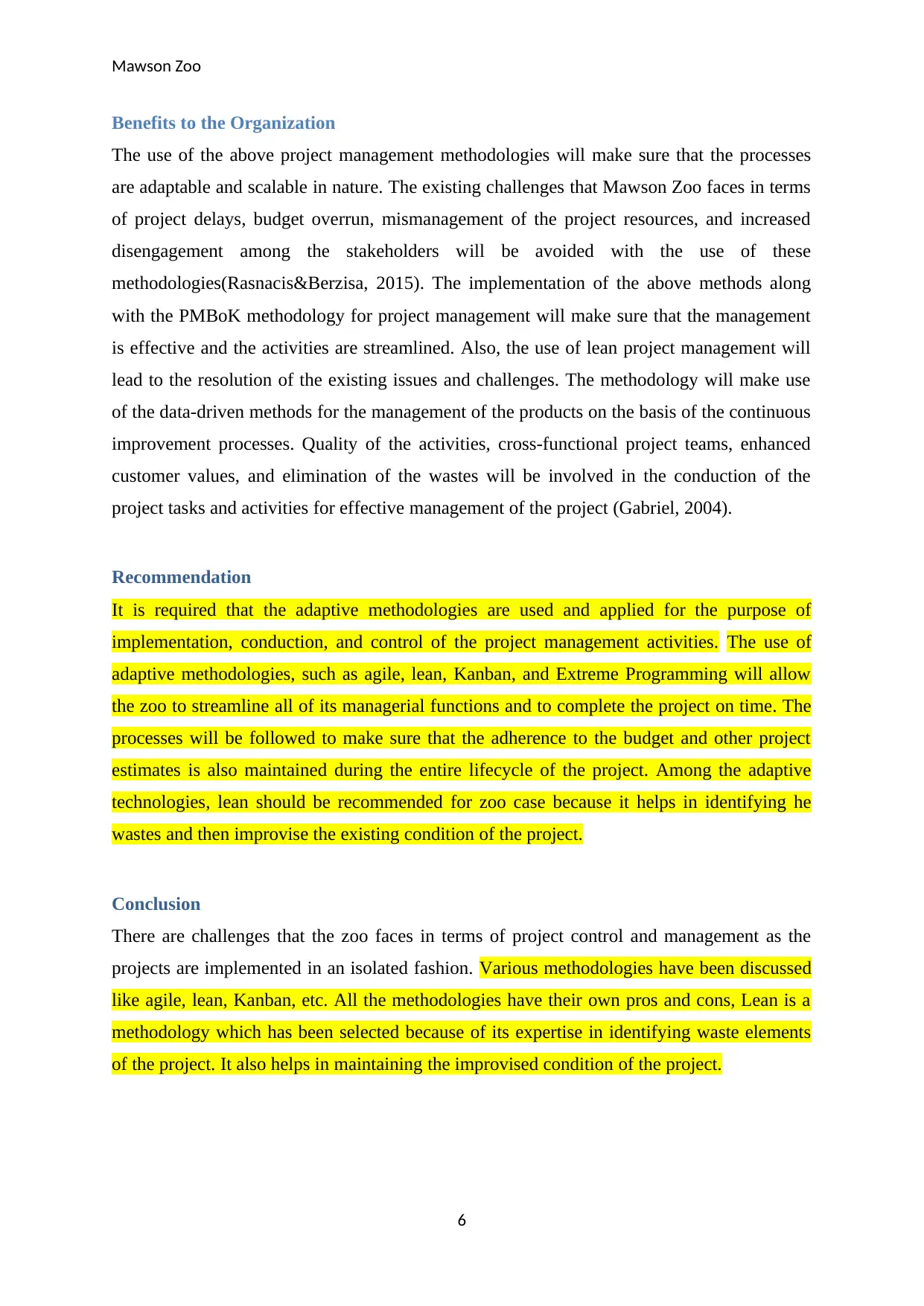
Mawson Zoo
Benefits to the Organization
The use of the above project management methodologies will make sure that the processes
are adaptable and scalable in nature. The existing challenges that Mawson Zoo faces in terms
of project delays, budget overrun, mismanagement of the project resources, and increased
disengagement among the stakeholders will be avoided with the use of these
methodologies(Rasnacis&Berzisa, 2015). The implementation of the above methods along
with the PMBoK methodology for project management will make sure that the management
is effective and the activities are streamlined. Also, the use of lean project management will
lead to the resolution of the existing issues and challenges. The methodology will make use
of the data-driven methods for the management of the products on the basis of the continuous
improvement processes. Quality of the activities, cross-functional project teams, enhanced
customer values, and elimination of the wastes will be involved in the conduction of the
project tasks and activities for effective management of the project (Gabriel, 2004).
Recommendation
It is required that the adaptive methodologies are used and applied for the purpose of
implementation, conduction, and control of the project management activities. The use of
adaptive methodologies, such as agile, lean, Kanban, and Extreme Programming will allow
the zoo to streamline all of its managerial functions and to complete the project on time. The
processes will be followed to make sure that the adherence to the budget and other project
estimates is also maintained during the entire lifecycle of the project. Among the adaptive
technologies, lean should be recommended for zoo case because it helps in identifying he
wastes and then improvise the existing condition of the project.
Conclusion
There are challenges that the zoo faces in terms of project control and management as the
projects are implemented in an isolated fashion. Various methodologies have been discussed
like agile, lean, Kanban, etc. All the methodologies have their own pros and cons, Lean is a
methodology which has been selected because of its expertise in identifying waste elements
of the project. It also helps in maintaining the improvised condition of the project.
6
Benefits to the Organization
The use of the above project management methodologies will make sure that the processes
are adaptable and scalable in nature. The existing challenges that Mawson Zoo faces in terms
of project delays, budget overrun, mismanagement of the project resources, and increased
disengagement among the stakeholders will be avoided with the use of these
methodologies(Rasnacis&Berzisa, 2015). The implementation of the above methods along
with the PMBoK methodology for project management will make sure that the management
is effective and the activities are streamlined. Also, the use of lean project management will
lead to the resolution of the existing issues and challenges. The methodology will make use
of the data-driven methods for the management of the products on the basis of the continuous
improvement processes. Quality of the activities, cross-functional project teams, enhanced
customer values, and elimination of the wastes will be involved in the conduction of the
project tasks and activities for effective management of the project (Gabriel, 2004).
Recommendation
It is required that the adaptive methodologies are used and applied for the purpose of
implementation, conduction, and control of the project management activities. The use of
adaptive methodologies, such as agile, lean, Kanban, and Extreme Programming will allow
the zoo to streamline all of its managerial functions and to complete the project on time. The
processes will be followed to make sure that the adherence to the budget and other project
estimates is also maintained during the entire lifecycle of the project. Among the adaptive
technologies, lean should be recommended for zoo case because it helps in identifying he
wastes and then improvise the existing condition of the project.
Conclusion
There are challenges that the zoo faces in terms of project control and management as the
projects are implemented in an isolated fashion. Various methodologies have been discussed
like agile, lean, Kanban, etc. All the methodologies have their own pros and cons, Lean is a
methodology which has been selected because of its expertise in identifying waste elements
of the project. It also helps in maintaining the improvised condition of the project.
6
Paraphrase This Document
Need a fresh take? Get an instant paraphrase of this document with our AI Paraphraser
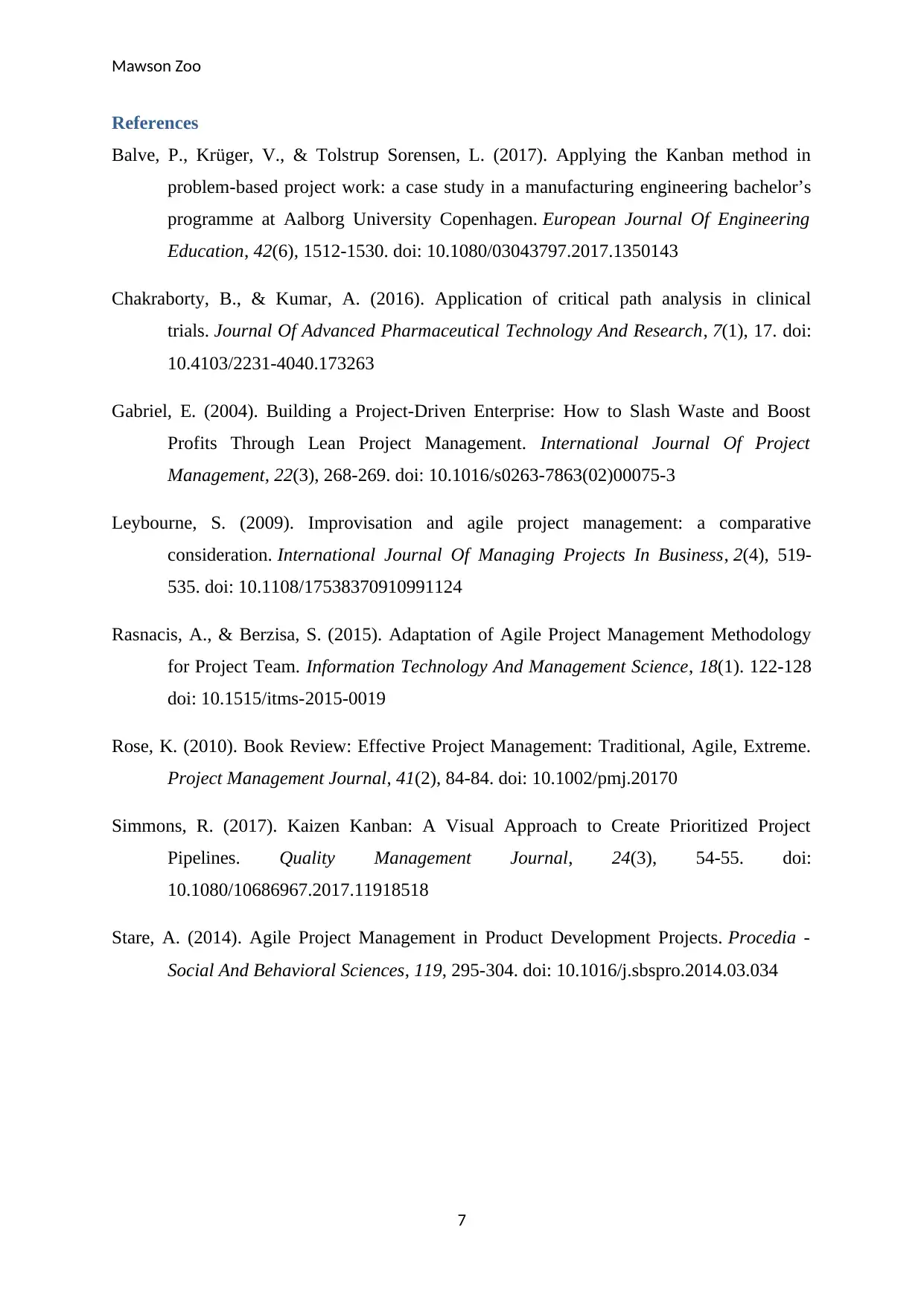
Mawson Zoo
References
Balve, P., Krüger, V., & Tolstrup Sorensen, L. (2017). Applying the Kanban method in
problem-based project work: a case study in a manufacturing engineering bachelor’s
programme at Aalborg University Copenhagen. European Journal Of Engineering
Education, 42(6), 1512-1530. doi: 10.1080/03043797.2017.1350143
Chakraborty, B., & Kumar, A. (2016). Application of critical path analysis in clinical
trials. Journal Of Advanced Pharmaceutical Technology And Research, 7(1), 17. doi:
10.4103/2231-4040.173263
Gabriel, E. (2004). Building a Project-Driven Enterprise: How to Slash Waste and Boost
Profits Through Lean Project Management. International Journal Of Project
Management, 22(3), 268-269. doi: 10.1016/s0263-7863(02)00075-3
Leybourne, S. (2009). Improvisation and agile project management: a comparative
consideration. International Journal Of Managing Projects In Business, 2(4), 519-
535. doi: 10.1108/17538370910991124
Rasnacis, A., & Berzisa, S. (2015). Adaptation of Agile Project Management Methodology
for Project Team. Information Technology And Management Science, 18(1). 122-128
doi: 10.1515/itms-2015-0019
Rose, K. (2010). Book Review: Effective Project Management: Traditional, Agile, Extreme.
Project Management Journal, 41(2), 84-84. doi: 10.1002/pmj.20170
Simmons, R. (2017). Kaizen Kanban: A Visual Approach to Create Prioritized Project
Pipelines. Quality Management Journal, 24(3), 54-55. doi:
10.1080/10686967.2017.11918518
Stare, A. (2014). Agile Project Management in Product Development Projects. Procedia -
Social And Behavioral Sciences, 119, 295-304. doi: 10.1016/j.sbspro.2014.03.034
7
References
Balve, P., Krüger, V., & Tolstrup Sorensen, L. (2017). Applying the Kanban method in
problem-based project work: a case study in a manufacturing engineering bachelor’s
programme at Aalborg University Copenhagen. European Journal Of Engineering
Education, 42(6), 1512-1530. doi: 10.1080/03043797.2017.1350143
Chakraborty, B., & Kumar, A. (2016). Application of critical path analysis in clinical
trials. Journal Of Advanced Pharmaceutical Technology And Research, 7(1), 17. doi:
10.4103/2231-4040.173263
Gabriel, E. (2004). Building a Project-Driven Enterprise: How to Slash Waste and Boost
Profits Through Lean Project Management. International Journal Of Project
Management, 22(3), 268-269. doi: 10.1016/s0263-7863(02)00075-3
Leybourne, S. (2009). Improvisation and agile project management: a comparative
consideration. International Journal Of Managing Projects In Business, 2(4), 519-
535. doi: 10.1108/17538370910991124
Rasnacis, A., & Berzisa, S. (2015). Adaptation of Agile Project Management Methodology
for Project Team. Information Technology And Management Science, 18(1). 122-128
doi: 10.1515/itms-2015-0019
Rose, K. (2010). Book Review: Effective Project Management: Traditional, Agile, Extreme.
Project Management Journal, 41(2), 84-84. doi: 10.1002/pmj.20170
Simmons, R. (2017). Kaizen Kanban: A Visual Approach to Create Prioritized Project
Pipelines. Quality Management Journal, 24(3), 54-55. doi:
10.1080/10686967.2017.11918518
Stare, A. (2014). Agile Project Management in Product Development Projects. Procedia -
Social And Behavioral Sciences, 119, 295-304. doi: 10.1016/j.sbspro.2014.03.034
7
1 out of 8
Related Documents
Your All-in-One AI-Powered Toolkit for Academic Success.
+13062052269
info@desklib.com
Available 24*7 on WhatsApp / Email
![[object Object]](/_next/static/media/star-bottom.7253800d.svg)
Unlock your academic potential
Copyright © 2020–2025 A2Z Services. All Rights Reserved. Developed and managed by ZUCOL.




